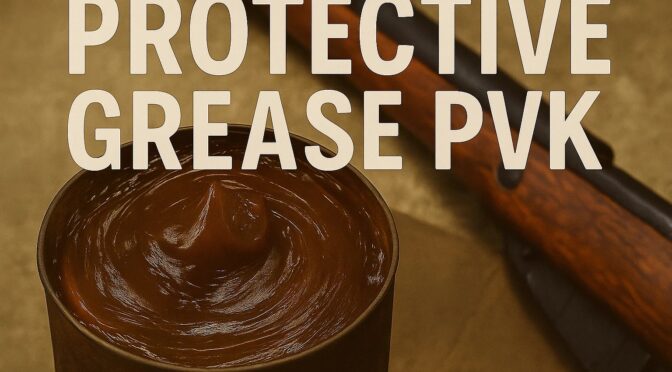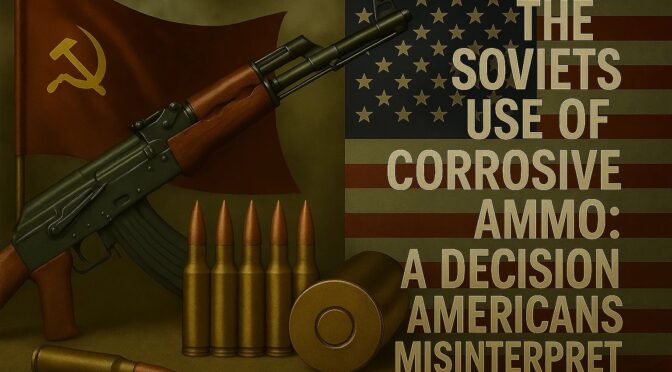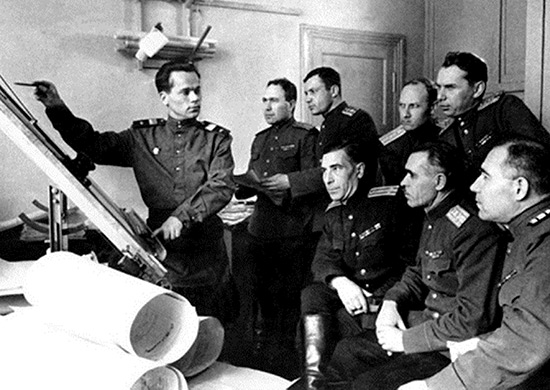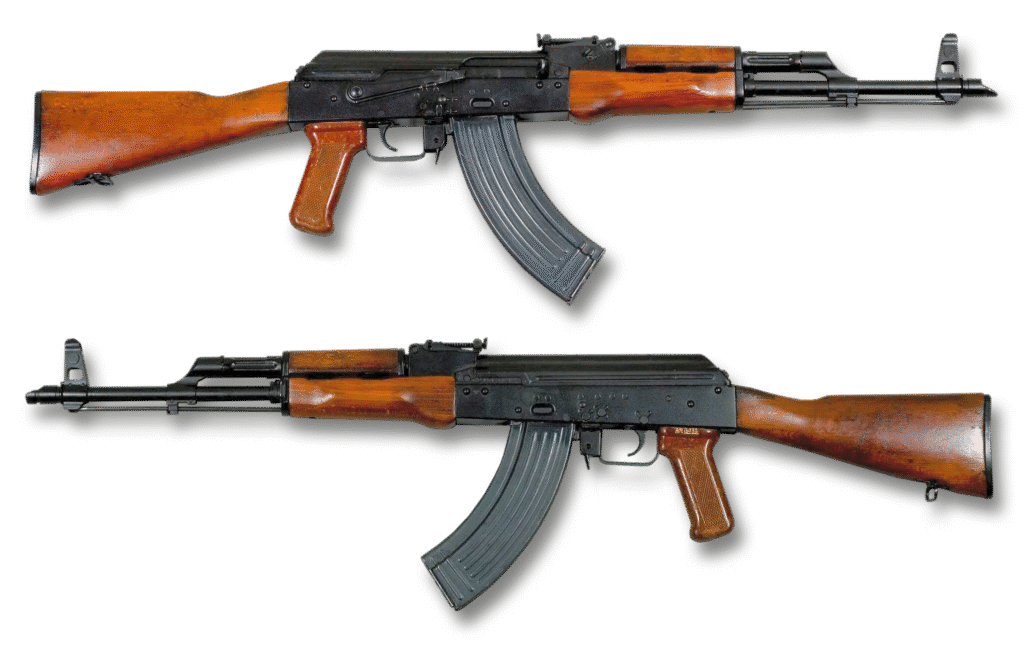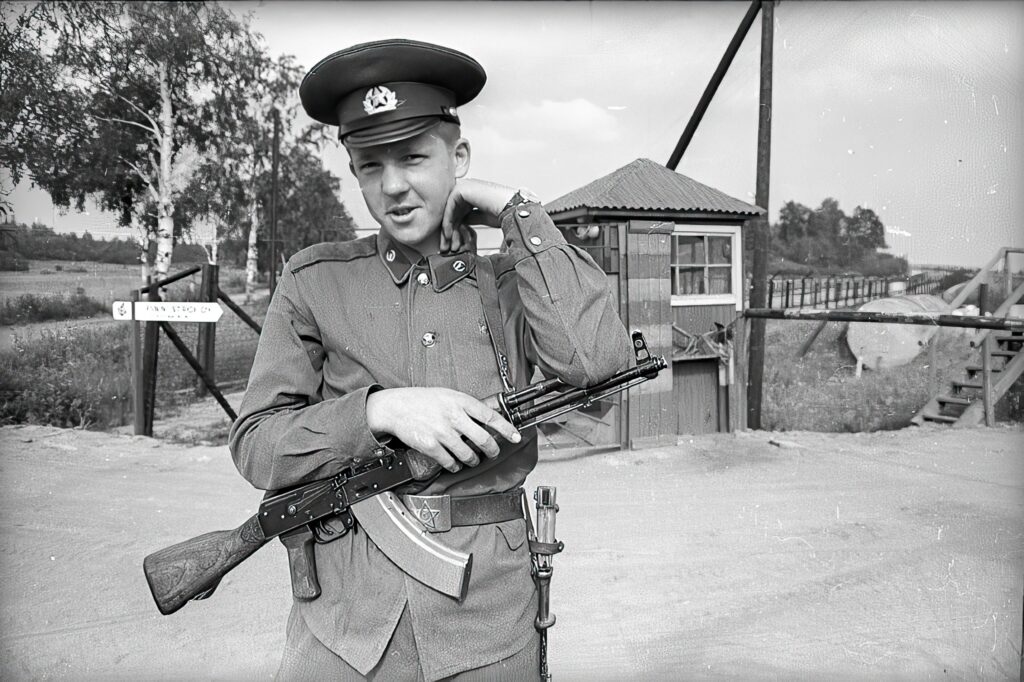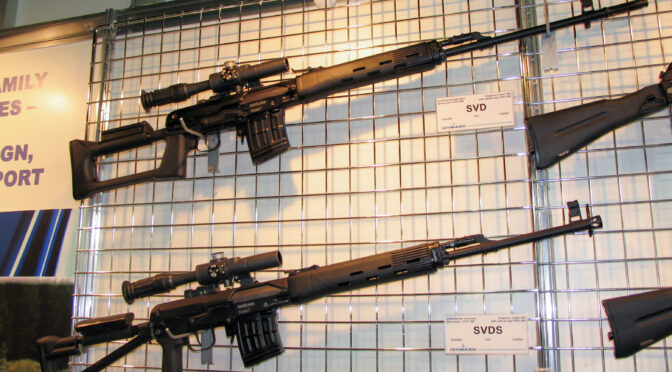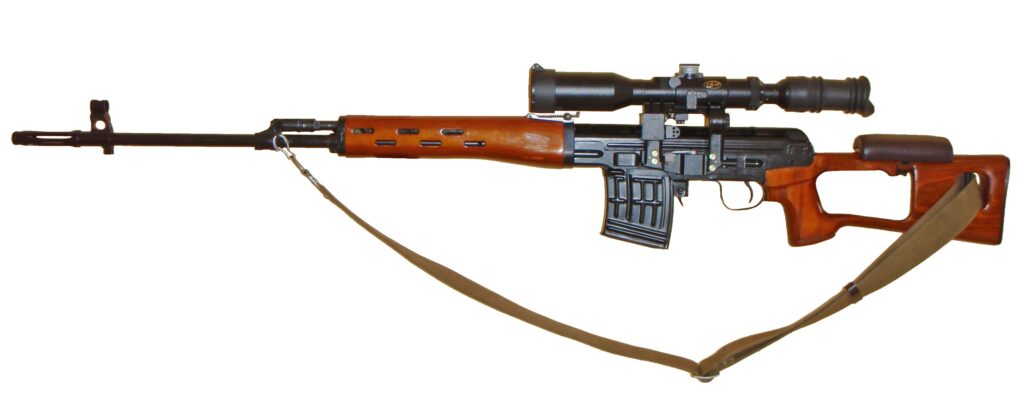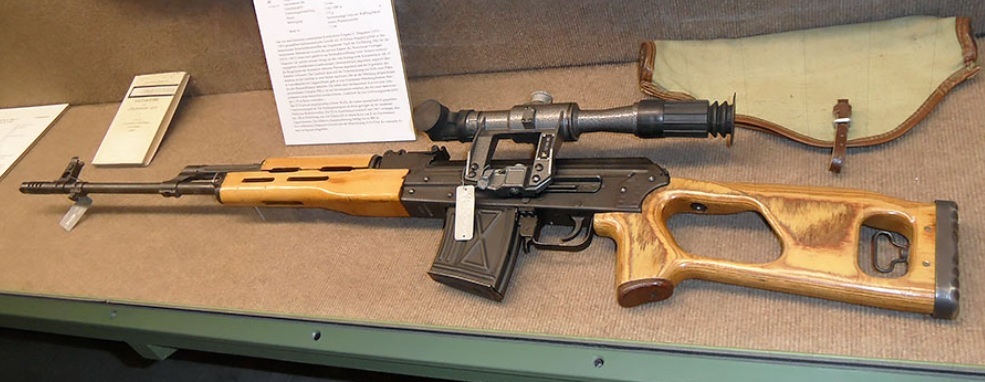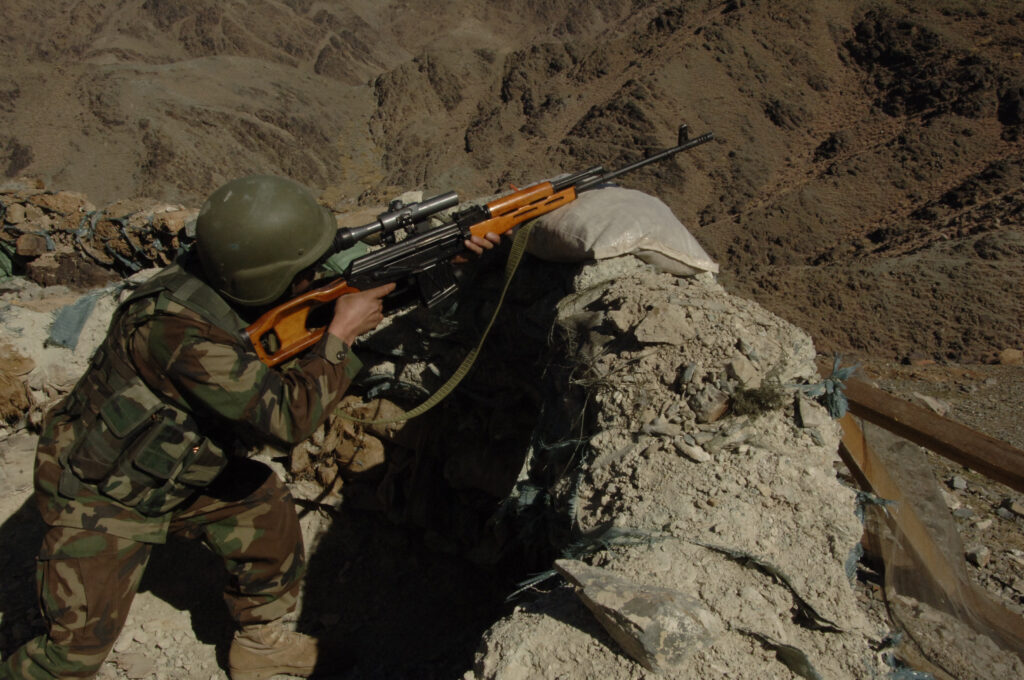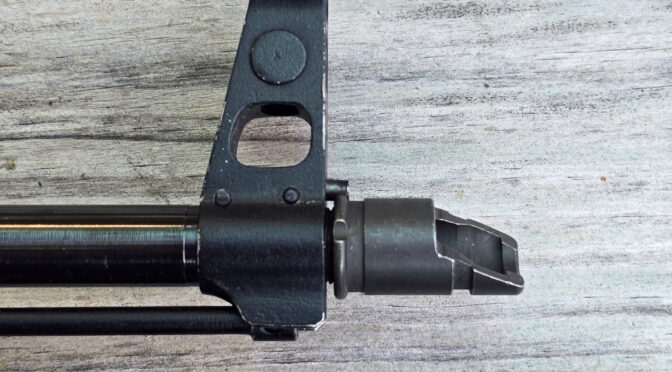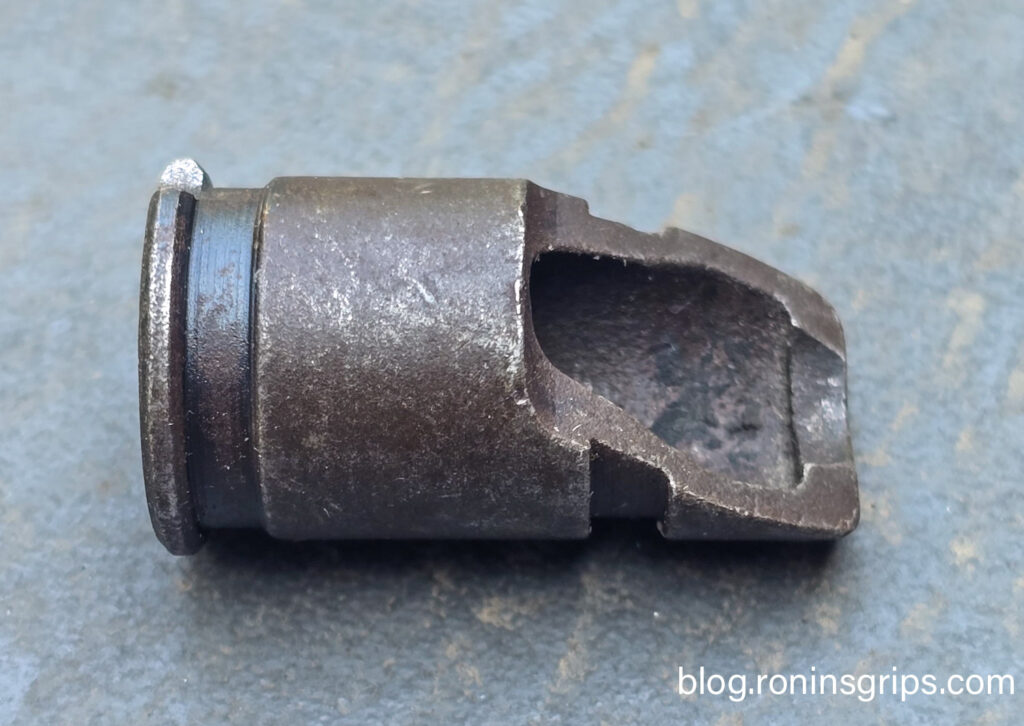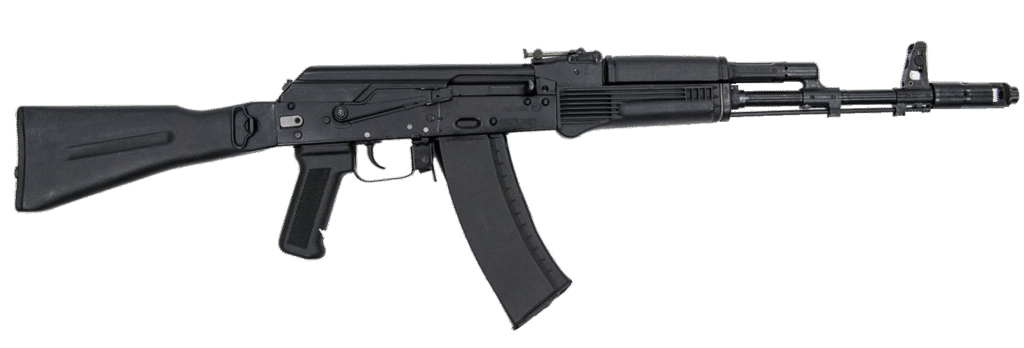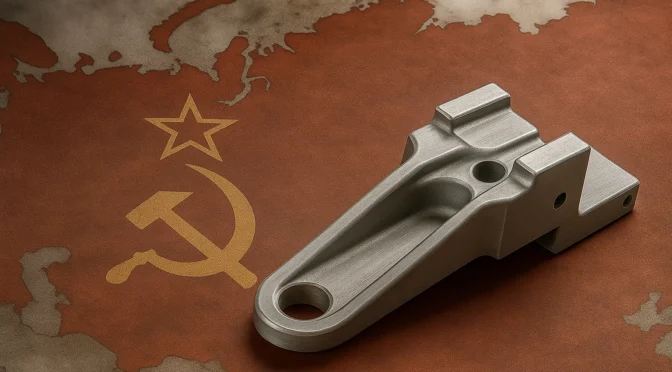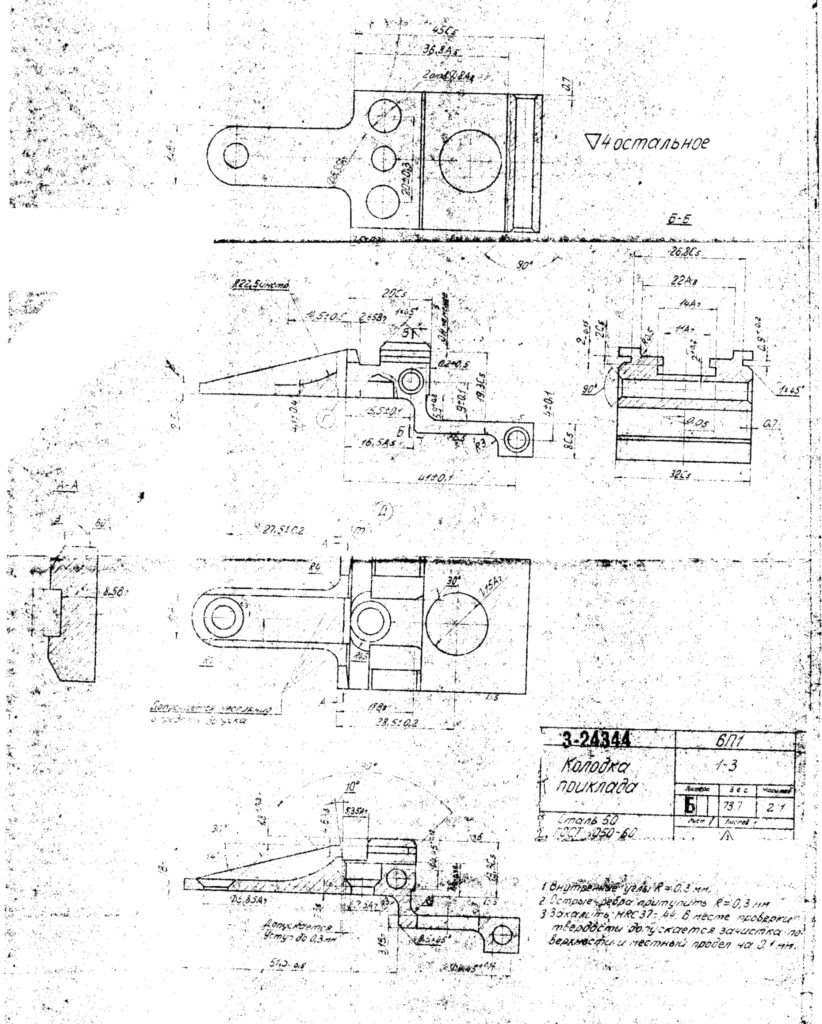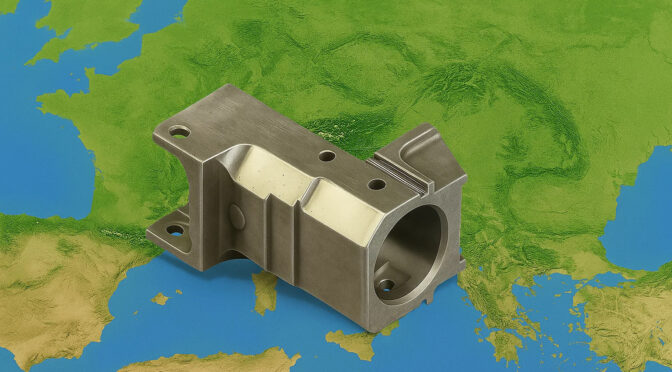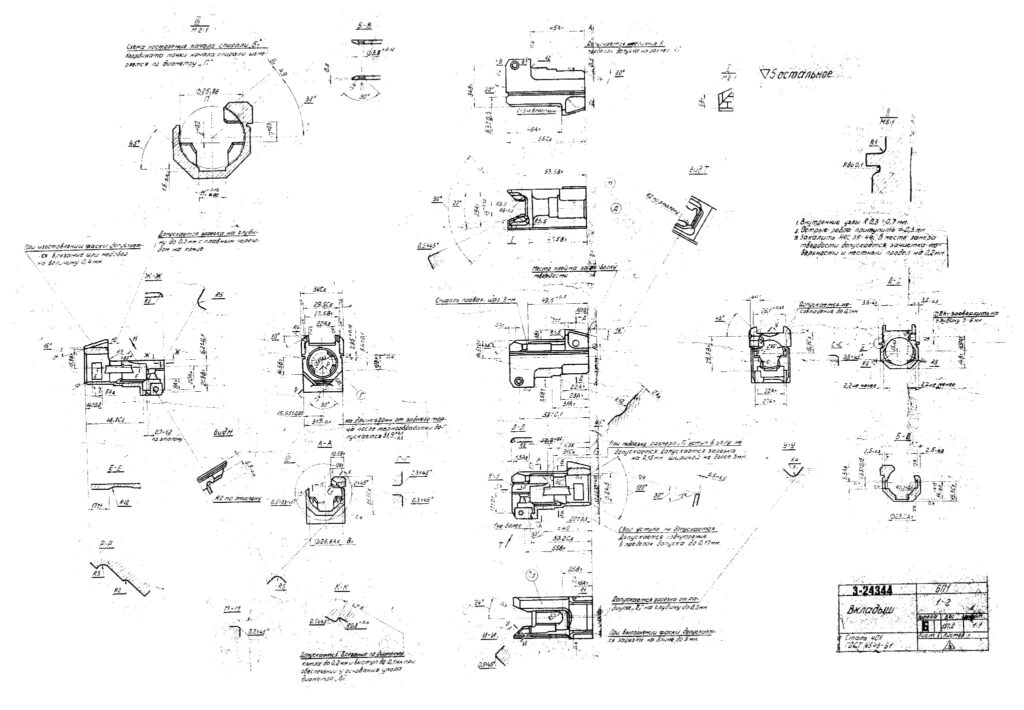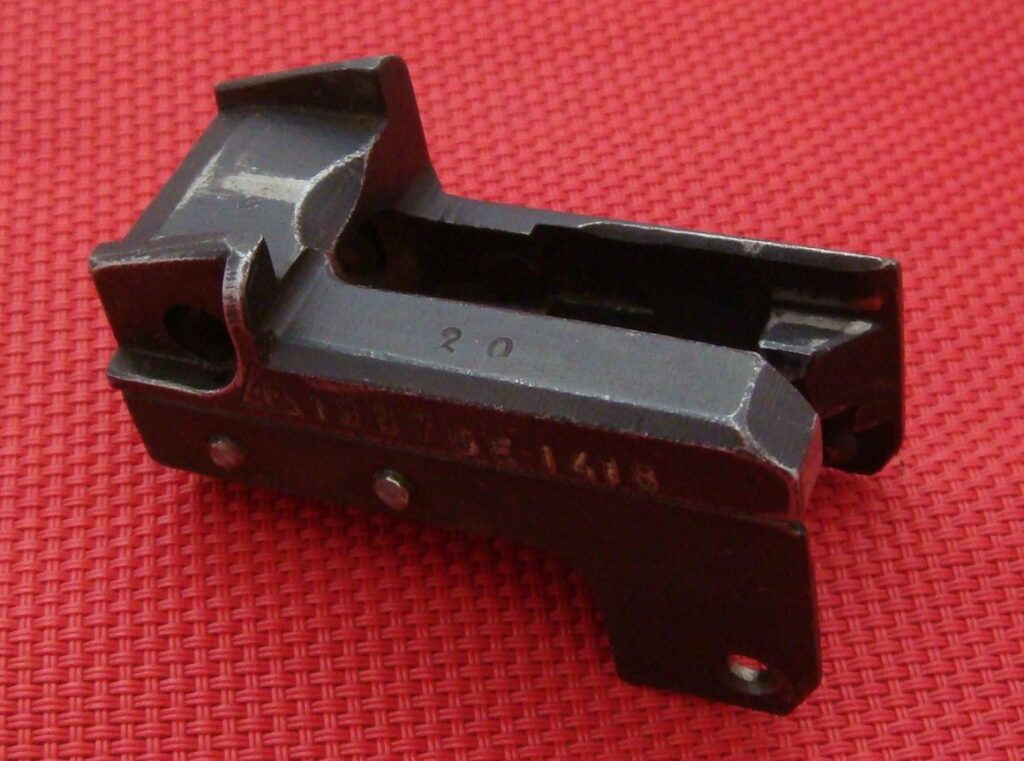The enduring rivalry between Soviet and American small arms design is not a simple narrative of superior versus inferior technology. Rather, it represents two profoundly different answers to the fundamental question: “What wins wars?”.1 The American answer, shaped by a doctrine of technological supremacy and faith in the highly trained professional soldier, resulted in weapons that prioritized precision, advanced materials, and ergonomic refinement. The Soviet answer, forged in the crucible of the Second World War’s Eastern Front, was one of industrial might, doctrinal pragmatism, and the resilience of a massive conscript army. This divergence in military philosophy created a chasm of understanding, leading Western analysts to frequently misinterpret calculated Soviet design choices as evidence of backwardness or “crudeness”.1
Soviet military doctrine, rooted in concepts like “Deep Battle,” envisioned a future conflict as a vast, multi-echeloned struggle of attrition where equipment would be consumed at an astronomical rate.3 In this context, the guiding principle became quantity over quality, where a weapon that was “good enough” but available in overwhelming numbers was superior to a perfect weapon that was not.2 Soviet small arms were therefore designed as tools for a nation in arms. They had to be simple enough for a peasant with minimal training to use and maintain, tough enough to survive the mud of a spring thaw or the ice of a Russian winter, and, most importantly, simple enough to be mass-produced in almost any machine shop by a largely unskilled workforce.1
Conversely, the American military evolved into an all-volunteer, professional force, where the individual soldier was a significant investment in training and expertise.8 U.S. doctrine sought technological “overmatch” to counter potential numerical disadvantages, leading to a preference for complex, often expensive, and meticulously engineered weapon systems.2 These weapons demanded rigorous maintenance and skilled operation but promised superior performance in the hands of a professional.
This philosophical divide led to frequent Western mischaracterization of Soviet designs. Features like un-ground rivets, the use of common steel instead of exotic alloys, and a general lack of crew comforts were seen not as deliberate trade-offs but as signs of a primitive industrial base.1 This perspective failed to grasp the ruthless logic at play. As the defector Victor Suvorov noted in an anecdote comparing an American and a Soviet tank, the American tank’s automatic transmission was superior in peacetime, but the Soviet manual transmission was superior in a war where advanced factories were likely to be destroyed by bombing, making complex parts impossible to mass-produce.1 The following ten examples will deconstruct this “crudeness” misconception, demonstrating how specific Soviet design features were, in hindsight, sophisticated and pragmatic solutions perfectly aligned with the USSR’s military doctrine, industrial reality, and uncompromising vision of total war.
Table 1: Comparative Design Philosophies: Soviet vs. American Small Arms
| Feature | Soviet Design Philosophy | American Design Philosophy |
| Target User | Conscript with minimal training | Professional soldier with extensive training |
| Core Principle | Absolute reliability and ease of mass production | Maximum performance and technological superiority |
| Manufacturing | Stamped steel, simple machining, designed for unskilled labor and rapid scale-up | Forged alloys, precision machining, advanced materials (e.g., aluminum, polymers) |
| Tolerances | Generous clearances for reliability in adverse conditions | Tight tolerances for enhanced accuracy |
| Ergonomics | Designed for gross motor skills, use with gloves, extreme durability | Designed for speed, efficiency, and user comfort |
| Maintenance | Minimal field maintenance required; forgiving of neglect | Regular, meticulous cleaning and maintenance expected |
| Ammunition | Cartridge geometry designed to enhance mechanical reliability (e.g., tapered case) | Cartridge designed to maximize ballistic performance (e.g., high velocity) |
| Design Trajectory | Incremental, evolutionary improvements on a proven platform | Revolutionary, “clean-sheet” designs pushing the state of the art |
| Doctrinal Goal | Equip a massive, mobilized army to win an attritional war through volume of fire | Equip a professional army to win engagements through individual lethality and overmatch |
The Top 10 Misunderstood Designs
1. The “Loose Tolerances” Fallacy: AK-47 Reliability Engineering
The American Misconception: Western engineers and armorers, accustomed to the precise, tight-fitting components of rifles like the M1 Garand and later the M16, viewed the rattling parts and visible gaps in the AK-47’s action as clear evidence of poor quality control and sloppy manufacturing.12 The weapon’s legendary reliability was often simplistically, and incorrectly, attributed to “loose tolerances,” implying that the parts were made inconsistently.
The Soviet Reality: Deliberate Clearances: The AK-47’s design was not based on imprecise manufacturing but on the deliberate inclusion of generous clearances between the moving parts, particularly the bolt carrier group and the receiver rails.12 This was a calculated engineering choice. These gaps created space for debris—such as mud, sand, carbon fouling, or ice—to be pushed aside by the powerful action rather than causing the weapon to jam.15 This principle was famously demonstrated in Vietnam when U.S. Army officer David Hackworth pulled a Viet Cong AK-47 from a marsh where it had been buried for a year and fired a full magazine without issue.17
This reliability is the result of a trio of interconnected design features:
- Generous Clearances: As noted, these spaces allow the weapon to function when heavily contaminated. The trigger group housing is also notably spacious compared to the tightly packed fire control group of an AR-15, making it far more resistant to being disabled by debris.18
- Long-Stroke Gas Piston: The gas piston is permanently attached to the massive bolt carrier, and the entire assembly moves as a single, heavy unit. This significant mass carries a great deal of momentum, allowing it to forcefully chamber a round and extract a spent casing, effectively powering through fouling or obstructions that would halt a lighter, more complex bolt carrier group.15
- Over-gassing: The system is intentionally designed to use more propellant gas than is strictly necessary to cycle the action.15 This results in a famously violent extraction and ejection cycle—energetically “yeeting” the spent case far from the weapon—but it guarantees the action has enough power to function reliably even with low-quality ammunition or in extremely fouled conditions.15
This combination came at the cost of inherent accuracy. The heavy, shifting mass of the piston and bolt carrier group makes the rifle less stable during firing than a weapon with a lighter, more refined operating system.12 However, for the Soviet doctrine of providing massed, suppressive fire by conscripts within an effective range of 300 meters, this trade-off was perfectly acceptable.24 The design brilliantly accommodated the realities of the Soviet Union’s post-war manufacturing capabilities. Achieving consistently tight tolerances across millions of rifles from dozens of factories was an immense industrial challenge.19 Kalashnikov’s design embraced this reality. The generous clearances meant that a bolt carrier from one factory would function in a receiver from another, even with minor dimensional variances. This turned a manufacturing limitation into a decisive battlefield strength, a concept American engineers, focused on the performance of a single, perfectly made rifle, failed to appreciate.
2. Stamped vs. Milled Receivers: The AKM and the Genius of Mass Production
The American Misconception: The original AK-47 featured a receiver machined from a solid block of steel, a process known as milling. In 1959, the Soviets introduced the modernized AKM, which used a receiver formed from a stamped 1 mm sheet of steel held together with rivets.23 To Western observers, this was a clear step backward. Stamped metal was associated with cheap, disposable World War II submachine guns like the American M3 “Grease Gun,” not a primary service rifle for a superpower.27 The move was widely seen as a cost-cutting measure that compromised the weapon’s strength and longevity.
The Soviet Reality: A Manufacturing Revolution: The transition to a stamped receiver was a strategic-industrial masterstroke that perfectly aligned with Soviet military doctrine. The initial milled AK-47, while durable, was slow and expensive to produce, with high rejection rates during early production runs.28 The stamped AKM receiver solved this problem, enabling production on a scale previously unimaginable.
- Speed and Cost: Stamping a receiver takes minutes and requires relatively simple machinery, whereas milling is a time-consuming, resource-intensive process.7 This change drastically cut the cost and production time per rifle, from over 13 hours for a PPD-40 to under 6 hours for a PPSh-41, a principle perfected in the AKM.7
- Labor and Resources: Stamping uses less-skilled labor and wastes far less raw steel than milling, which carves the final shape from a solid block. This was a critical advantage for the Soviet centrally planned economy.31
- Weight Reduction: The stamped receiver made the AKM significantly lighter than the milled AK-47, reducing its loaded weight from approximately 4.8 kg to 3.8 kg, a substantial improvement for the foot soldier.23
The AKM’s stamped receiver was not a crude piece of metalwork. It was a sophisticated design that used a machined front trunnion—a separate steel block into which the barrel is pressed and the bolt locks—riveted into the sheet metal body. This provided the necessary strength precisely where it was needed, while allowing the rest of the receiver to be light and easy to produce. This shift was a direct reflection of the doctrinal need for rapid, massive mobilization. While Western contemporaries like the FN FAL retained heavy, forged-and-milled receivers for maximum rigidity 34, the Soviets prioritized the ability to arm a multi-million-man army in the event of a total war. The American perception of the stamped receiver as “cheap” missed the point; it was a strategic solution where the rate of production was itself a key performance metric of the weapon system.
3. The Tapered Case: 7.62x39mm Cartridge and Magazine Design
The American Misconception: American ballisticians often dismissed the Soviet 7.62x39mm cartridge as mediocre. Compared to the high-velocity, flat-shooting 5.56x45mm NATO round, the Soviet cartridge had a more pronounced, looping trajectory, limiting its effective accuracy at longer ranges.35 The distinctive curved “banana” magazine of the AK-47 was often seen as little more than a stylistic flourish.
The Soviet Reality: Designing the Cartridge for the Gun: The genius of the 7.62x39mm lies not in its long-range ballistic performance but in the physical geometry of its case, which was designed from the ground up to ensure flawless mechanical reliability in an automatic weapon.
- Pronounced Body Taper: The cartridge case has a significant conical shape, or taper, from its base to its shoulder.35 This is not an accident; it is the key to the AK’s feeding and extraction cycle. During feeding, the cone shape acts like a funnel, guiding the round into the chamber with minimal resistance.19 During extraction, the taper means that a very slight rearward movement is enough to break the case free from the chamber walls, drastically reducing the force needed to pull it out.37 This is a massive advantage in a dirty or oversized chamber.
- The Inevitable Curve: This pronounced taper means that when rounds are stacked, they cannot form a straight line; they naturally form an arc. The iconic curved magazine is therefore a direct mechanical necessity dictated by the shape of the ammunition it holds.24
In stark contrast, the American 5.56x45mm cartridge has a nearly straight-walled case.40 This design is more efficient in terms of case volume but makes extraction far more difficult, as a much larger surface area is in contact with the chamber walls. This is a primary reason why the AR-15’s direct impingement system is less tolerant of fouling—it lacks the raw power and mechanical advantage of the AK’s system to rip a stubborn, straight-walled case from a dirty chamber. The Americans evaluated the 7.62x39mm cartridge in isolation, focusing on its ballistics. The Soviets designed a holistic system, where the tapered case (for reliability), the curved magazine (a consequence of the case), and the powerful long-stroke piston action were three inseparable components of a single, unified design philosophy. Criticizing the cartridge’s trajectory without acknowledging how its shape enables the rifle’s legendary reliability is a fundamental misunderstanding of the design’s purpose.
4. Overwhelming Firepower: The PPSh-41’s “Wasteful” Rate of Fire
The American Misconception: With a blistering cyclic rate of 900 to 1,250 rounds per minute, the PPSh-41 submachine gun was often viewed by Western observers as an uncontrollable and inaccurate “bullet hose” that wasted ammunition.27 Compared to the more sedate rates of fire of the German MP40 (~500 rpm) or the American M3 “Grease Gun” (~450 rpm), the Soviet weapon seemed crude and undisciplined.42
The Soviet Reality: Firepower as a Doctrinal Weapon: The extremely high rate of fire was a deliberate tactical feature, born from the brutal lessons of close-quarters combat in the Winter War with Finland and the urban warfare of Stalingrad.7 The goal was not individual marksmanship but achieving immediate and overwhelming fire superiority.
- Shock and Suppression: The psychological impact of a squad of PPSh-41s opening fire was immense. The sheer volume of lead was devastatingly effective at suppressing enemy positions, pinning defenders down and allowing Soviet assault troops to advance.43 An American infantry captain in the Korean War noted that in close-range fights, the PPSh-41 “outclassed and outgunned what we had”.41
- Mass Production for Mass Armament: The weapon was ingeniously designed for mass production, using stamped steel parts that could be made quickly and cheaply.30 This allowed the Red Army to issue the PPSh-41 not just to specialists or NCOs, but to entire companies and even regiments, arming the common rifleman with automatic firepower on a scale unseen in other armies.1
- The 71-Round Drum Magazine: To feed this high rate of fire, the PPSh-41 was famously issued with a 71-round drum magazine. While sometimes prone to feeding issues and slow to load, it provided the capacity needed to sustain suppressive fire during an assault without constant reloading.7
American small arms doctrine has always been heavily influenced by a tradition of individual marksmanship, where the goal is “one shot, one kill.” The PPSh-41 was not designed for this. The Soviets viewed the submachine gun as a squad-level area weapon, where the density of fire in a given area—a trench, a window, a doorway—was more important than the accuracy of any single shot. This thinking aligns with the broader Soviet doctrine of “massed fires,” which they famously applied with their Katyusha rocket artillery.2 Judging the PPSh-41 by the standards of a marksman’s rifle is to apply the wrong metric. It was a tool of shock and suppression, and by that measure, its “wasteful” rate of fire was a brilliantly effective design.
5. The Squad’s Sniper: Misunderstanding the SVD Dragunov’s DMR Role
The American Misconception: When Western intelligence first encountered the SVD Dragunov, it was immediately labeled a “sniper rifle.” Judged against American sniper systems like the bolt-action M40 or the accurized M21, the SVD seemed deficient. It was a semi-automatic with a relatively thin barrel, was only capable of about 2-3 MOA accuracy with standard ammunition, and was equipped with a simple, low-magnification 4x scope.45 Its cosmetic resemblance to the AK-47 also led many to incorrectly dismiss it as a mere “accurized AK”.45
The Soviet Reality: Inventing the Designated Marksman Rifle (DMR): The SVD was never meant to be a sniper rifle in the Western sense of a specialized, independent operator. It was, in fact, the world’s first purpose-built Designated Marksman Rifle, a tactical role that the U.S. military would not formally adopt for decades.49
- Filling a Doctrinal Gap: The SVD was created to solve a specific problem. Standard Soviet infantry squads armed with AK-47s (7.62x39mm) were effective out to about 300 meters. Their NATO counterparts, however, were armed with full-power battle rifles like the FN FAL (7.62x51mm), which could effectively engage targets out to 600 meters.45 The SVD, chambered in the powerful 7.62x54R cartridge, was issued one per squad to provide an organic capability to counter this range disadvantage.45
- A Squad-Level Asset: Unlike a Western sniper team that operates autonomously, the SVD-equipped marksman was an integral member of his infantry squad.45 The rifle’s light weight (for its class) and semi-automatic action were essential for the marksman to keep pace with his squad during an advance and to rapidly engage multiple targets.48
- “Good Enough” Accuracy: The rifle’s 2-3 MOA accuracy was more than sufficient for its intended purpose: hitting man-sized targets out to 600-800 meters.46 The goal was not the extreme precision of a traditional sniper, but providing effective, rapid, long-range suppressive fire against enemy machine gunners, officers, and other high-value targets.54
The SVD is a perfect example of a weapon designed backward from a clearly defined doctrinal need. Its features, including the AK-like manual of arms for training commonality and even a bayonet lug—bizarre for a “sniper rifle” but logical for a squad member who could be engaged at close quarters—are all direct consequences of its intended role.45 The West misunderstood the SVD because it had no corresponding doctrinal category to place it in. The SVD was not a bad sniper rifle; it was a brilliant DMR that the U.S. had not yet conceived of.
6. Simple Blowback Power: The Makarov PM’s Elegant Sufficiency
The American Misconception: The Makarov PM pistol was often dismissed in the West as a crude, heavy, and underpowered copy of the German Walther PP.57 Its simple straight blowback operating mechanism was considered obsolete for a military sidearm when compared to more powerful locked-breech designs like the American Colt M1911A1. The proprietary 9x18mm Makarov cartridge was seen as a weak compromise, falling between the.380 ACP and the 9x19mm Parabellum.59
The Soviet Reality: Radical Simplicity and Reliability: The Makarov is an example in the Soviet design philosophy of achieving maximum utility through ruthless simplification.
- Blowback Operation: The straight blowback design, where the mass of the slide and the force of the recoil spring are the only things holding the breech closed, is mechanically simple and robust. It eliminates the need for the complex locking lugs, links, or tilting barrels found in more powerful handguns, resulting in fewer parts, lower manufacturing cost, and greater inherent accuracy due to its fixed barrel.57
- Optimized Cartridge: The 9x18mm cartridge was not a compromise but an optimization. It was engineered to be the most powerful cartridge that could be safely and reliably used in a compact, simple blowback pistol.57 Using the more powerful 9x19mm round would have required a much heavier slide or a more complex and expensive locked-breech mechanism, violating the core design principles.
- Drastic Parts Reduction: While visually similar to the Walther PP, Nikolai Makarov’s design was radically simplified, reducing the total parts count to just 27 (excluding the magazine).57 Many parts were designed to perform multiple functions; for instance, a single flat mainspring powers the hammer, trigger, and disconnector, while its base also serves as the magazine catch.57 This is a hallmark of brilliant, cost-effective engineering.
The American military, with its M1911 heritage, has historically viewed the pistol as a serious fighting weapon.64 The Soviets, however, saw the sidearm primarily as a defensive tool for officers, vehicle crews, and police—personnel for whom the rifle was the primary weapon.65 For this role, a weapon’s low cost, ease of issue, and ability to function after years of neglect in a holster were more important than raw power or ergonomic features like a fast magazine release. The American critique of the Makarov as “underpowered” stems from applying a “fighting pistol” standard to a gun that was brilliantly designed to be a simple, reliable “appliance.”
7. “Crude” Ergonomics: AK Safety Levers and Sights for the Conscript
The American Misconception: The ergonomics of the AK platform are a frequent point of criticism from Western shooters. The safety selector is a large, stamped steel lever on the right side of the receiver that is often stiff and requires the shooter to break their firing grip to operate—a stark contrast to the small, thumb-actuated safety on an M16.26 The iron sights are a simple open notch and post, considered far less precise than the aperture or “peep” sights common on American service rifles.67
The Soviet Reality: Design for Gross Motor Skills Under Duress: These features were not design flaws but deliberate choices made with the end-user—a conscript soldier in the worst possible conditions—in mind.
- The Safety/Selector Lever: The large size and long, deliberate throw of the AK safety lever ensure it can be operated by a soldier wearing thick winter gloves with numb fingers.18 It requires a gross motor movement, which is far more reliable under the extreme stress of combat than a control that requires fine motor skills. The lever also serves a secondary purpose as a dust cover, sealing the ejection port when in the “safe” position, a pragmatic feature that enhances the weapon’s overall reliability.38
- The Iron Sights: The simple notch-and-post sights are extremely durable and faster to acquire at the close ranges typical of infantry combat. While less precise for long-range marksmanship, they are more than adequate for the AK’s intended effective range of around 300 meters and are easier for a poorly trained soldier to use effectively. Soviet doctrine emphasized massed suppressive fire, not individual precision, making aperture sights an unnecessary complexity.25
American small arms are designed for a professional military that invests heavily in training.9 The M16’s controls are optimized for speed and efficiency in the hands of a skilled operator. The Soviet system, however, was built around mass conscription, with training focused on simple, rote battle drills.8 The AK’s “crude” ergonomics are a direct result of designing for this “worst-case user.” The controls are large, simple, and forceful because under extreme stress, fine motor skills degrade rapidly. The Soviets were not designing a rifle for a competition shooter; they were designing a tool of war for a peasant who needed to be able to use it effectively after only a few weeks of training.
8. Chrome-Lined Barrels: A Pragmatic Solution for Corrosive Ammunition and Neglect
The American Misconception: In the American firearms community, particularly in precision shooting circles, chrome-lining a barrel is often seen as detrimental to achieving maximum accuracy. The electroplating process can be difficult to apply with perfect uniformity, potentially creating microscopic inconsistencies in the bore that can degrade precision.71 This led to the perception that the ubiquitous chrome-lining of Soviet barrels was another example of sacrificing quality for mass production.
The Soviet Reality: A Non-Negotiable Necessity: For the Soviet military, chrome-lining was not an optional feature to extend barrel life; it was an absolute requirement driven by the realities of their ammunition supply and their target user.
- Corrosive Ammunition: For decades, the Soviet Union and its Warsaw Pact allies mass-produced billions of rounds of ammunition using Berdan primers with corrosive chemical compounds. After firing, these primers leave behind potassium chloride salts in the barrel. These salts are hygroscopic, meaning they attract moisture from the air, which leads to rapid and aggressive rusting that can destroy a barrel in a matter of days if not cleaned meticulously.72
- The Conscript Soldier: The Soviet command could not assume that every conscript would, or even could, properly clean their rifle immediately after every firing session, especially in the midst of combat.70
The solution was to plate the bore, chamber, and gas piston with a layer of hard chrome. This created an extremely hard, corrosion-resistant surface that protected the underlying steel from the corrosive salts.1 Any minor degradation in theoretical accuracy was an insignificant price to pay for ensuring the rifle would not be rendered useless by its own ammunition and the predictable neglect of its user. The American focus on the mechanical effect of chrome-lining (on accuracy) missed that for the Soviets, it was a vital solution to a massive logistical and chemical problem. It was simpler to “immunize” the rifle against the ammunition than to re-engineer the entire ammunition production and supply chain.
9. The “Poison Bullet” Myth: Terminal Ballistics of the 5.45x39mm
The American Misconception: When the Soviet Union introduced the AK-74 rifle and its new 5.45x39mm cartridge in the 1970s, its first major combat use was in Afghanistan. The devastating wounds it inflicted on the Mujahideen led to the nickname “poison bullet” and a widespread myth in the West that the Soviets had designed an illegal projectile that tumbled or expanded in violation of the Hague Convention.76
The Soviet Reality: Engineering for Instability: The gruesome wounding effects were not the result of poison or an illegal design, but of a highly sophisticated bullet engineered to maximize terminal performance from a small-caliber projectile.
- The 7N6 Bullet Design: The standard 5.45x39mm 7N6 projectile consists of a full metal jacket over a mild steel penetrator core. Critically, between the tip of the penetrator and the inside of the jacket nose, there is a small, hollow air pocket.77
- Center of Gravity Manipulation: This air pocket has a profound effect on the bullet’s flight dynamics upon impact. It shifts the bullet’s center of gravity significantly toward its rear. When the bullet strikes a denser medium like soft tissue, the nose deforms slightly, and the rear-heavy design causes it to become unstable almost instantly, yawing and tumbling end-over-end.78
- Tumbling vs. Fragmentation: This violent tumbling action transfers a massive amount of energy to the surrounding tissue, creating a much larger wound cavity than a bullet that passes straight through. Unlike the early American 5.56mm M193 round, which relied on high velocity to cause it to fragment, the 5.45mm 7N6 round typically remains intact, achieving its effect primarily through this early and violent yaw.78
The “poison bullet” myth arose from a failure to distinguish a weapon’s effect from its intent. All pointed military rifle bullets will eventually tumble in tissue; the engineering challenge is to make them do so as early as possible to maximize energy transfer within the target.80 The Soviets, unable to rely on the extreme velocities that caused the M193 to fragment, found a different engineering solution: manipulating the bullet’s center of gravity. The resulting wounds were severe and highly prone to infection in the austere medical conditions of the Afghan conflict, leading to the “poison” moniker.78 The West saw a gruesome result and assumed malicious intent, failing to recognize a clever and effective piece of terminal ballistics engineering.
10. Incrementalism vs. Revolution: The Evolutionary Path of Soviet Arms
The American Misconception: To many Western observers, Soviet small arms development appeared stagnant. The progression from the AK-47 to the AKM to the AK-74 involved changes in manufacturing and caliber, but the core operating system and layout remained virtually unchanged for half a century. This was often contrasted with the American approach of pursuing revolutionary, “clean-sheet” designs, such as the dramatic leap from the M14 battle rifle to the space-age M16 assault rifle, and was seen as a lack of innovation.10
The Soviet Reality: The Power of Evolutionary Design: The Soviet approach was a deliberate and highly effective strategy of incrementalism.10 They would establish a robust, proven platform and then introduce gradual, low-risk improvements over decades.
- Risk Aversion: By evolving a proven design, they avoided the enormous risks and “teething problems” that often plague entirely new systems. The disastrous initial deployment of the M16 in Vietnam, where reliability issues led to American casualties, is a textbook example of the dangers of fielding a revolutionary but insufficiently tested design.15
- Logistical and Training Simplicity: Maintaining the same basic platform simplified the entire military ecosystem. Parts commonality was high, and the manual of arms remained consistent. A soldier trained on an AKM could be handed an AK-74 and use it effectively with no new training.45
- Manufacturing Continuity: This evolutionary path allowed the vast Soviet arms industry to use the same basic tooling and manufacturing processes for decades, refining them for efficiency rather than undertaking the massive expense of completely retooling for a new design. This was perfectly suited to a centrally planned economy.10
This misunderstanding stemmed from two different definitions of “improvement.” The American “weapons system concept” often sought revolutionary leaps in performance metrics—accuracy, weight, modularity—even if it meant a complete logistical reset and the risk of unforeseen failures.10 The Soviet approach defined improvement as a modest gain in performance with zero loss in reliability and minimal disruption to the existing industrial and training base. The Soviet evolutionary path was the ultimate expression of their risk-averse, pragmatic philosophy. They would rather field millions of very good, utterly reliable rifles than risk a battlefield debacle in the pursuit of a theoretically “perfect” one.
Conclusion: A Doctrine of Ruthless Pragmatism
The ten design features examined—from the generous clearances of the AK-47’s action to the decades-long incremental evolution of its design—were not a collection of independent, crude choices. They were the tightly interconnected facets of a single, coherent, and ruthlessly pragmatic military doctrine. The “loose” tolerances, stamped receivers, tapered cartridges, extreme rates of fire, the pioneering DMR concept, the radically simple pistols, the conscript-proof ergonomics, the mandatory chrome-lined barrels, the cleverly unstable bullets, and the evolutionary design path all trace back to the same set of core requirements.
This doctrine was forged by the Soviet Union’s unique historical experience and geopolitical worldview.1 It demanded weapons capable of arming a massive conscript army for a high-intensity, attritional war, to be produced by an industrial base that prioritized sheer scale over artisanal finesse. Every perceived flaw by Western standards was, in fact, a calculated trade-off that served this overarching strategic vision.
Ultimately, the fundamental misunderstanding can be distilled to a simple contrast in purpose. American small arms are designed for the soldier, as tools to make a highly trained professional more lethal and effective. Soviet small arms were designed for the state, as instruments to ensure the Red Army, as a massive, unified organism, would be unstoppable. Recognizing this profound difference in perspective is the key to appreciating the calculated genius behind designs once so easily dismissed as crude.
If you find this post useful, please share the link on Facebook, with your friends, etc. Your support is much appreciated and if you have any feedback, please email me at in**@*********ps.com. Please note that for links to other websites, we are only paid if there is an affiliate program such as Avantlink, Impact, Amazon and eBay and only if you purchase something. If you’d like to directly contribute towards our continued reporting, please visit our funding page.
Works cited
- The Soviet Union’s Philosophy Of Weapons Design | Quintus Curtius, accessed July 31, 2025, https://qcurtius.com/2016/09/15/the-soviet-unions-philosophy-of-weapons-design/
- The Soviet Union’s Best Weapons Could Have Killed Millions – The …, accessed July 31, 2025, https://nationalinterest.org/blog/buzz/soviet-unions-best-weapons-could-have-killed-millions-109301
- Deep operation – Wikipedia, accessed July 31, 2025, https://en.wikipedia.org/wiki/Deep_operation
- Deep Battle: Soviet Doctrine for Operational Level Warfare – Steven’s Balagan, accessed July 31, 2025, https://balagan.info/deep-battle-soviet-doctrine-for-operational-level-warfare
- Soviet Deep Operations Doctrine: Origins and Key Theorists – War and Civilization, accessed July 31, 2025, https://www.camrea.org/2024/09/05/soviet-deep-operations-doctrine-origins-and-key-theorists/
- A COMPARISON OF SOVIET AND US DEFENSE ACTIVITIES, 1973-87 – CIA, accessed July 31, 2025, https://www.cia.gov/readingroom/docs/DOC_0000969816.pdf
- PPSh-41 – the Gun That Saved Mother Russia – Recoil Magazine, accessed July 31, 2025, https://www.recoilweb.com/ppsh-41-the-gun-that-saved-mother-russia-104261.html
- How well trained were Soviet ground units during the Cold War? : r/WarCollege – Reddit, accessed July 31, 2025, https://www.reddit.com/r/WarCollege/comments/102kksx/how_well_trained_were_soviet_ground_units_during/
- How Do U.S. Soldiers Compare to Russian Soldiers? | by Hirok – Medium, accessed July 31, 2025, https://lifeexplore.medium.com/how-do-u-s-soldiers-compare-to-russian-soldiers-709428569354
- Armor Development in the Soviet Union and the United States, accessed July 31, 2025, https://www.rand.org/content/dam/rand/pubs/reports/2006/R1860.pdf
- Soviet weapons development, accessed July 31, 2025, https://www.tandfonline.com/doi/pdf/10.1080/04597237608460380
- ELI5: What makes the AK-47 one of the most reliable guns in the world? Why can’t other companies replicate this reliability? – Reddit, accessed July 31, 2025, https://www.reddit.com/r/explainlikeimfive/comments/3d54xf/eli5_what_makes_the_ak47_one_of_the_most_reliable/
- tolerance Specifications Impact on Reliability, accessed July 31, 2025, https://accendoreliability.com/tolerance-specifications-impact-reliability/
- What Makes an AK-47 So Reliable? – YouTube, accessed July 31, 2025, https://www.youtube.com/shorts/8prLU_UhGjg
- Soviet vs Western Small Arms : r/WarCollege – Reddit, accessed July 31, 2025, https://www.reddit.com/r/WarCollege/comments/1ckd0sm/soviet_vs_western_small_arms/
- How Does The Ak-47 Perform In Extreme Conditions? – GunCreed, accessed July 31, 2025, https://guncreed.com/how-does-the-ak47-perform-in-extreme-conditions/
- What was the impression of the AK-47/AKM when it was first encountered during the Vietnam War? : r/AskHistorians – Reddit, accessed July 31, 2025, https://www.reddit.com/r/AskHistorians/comments/28dom2/what_was_the_impression_of_the_ak47akm_when_it/
- Reliability of the AK-47 – the most important reasons – Zbrojownia …, accessed July 31, 2025, https://zbrojowniamodlin.pl/en/reliability-of-the-ak-47-the-most-important-reasons/
- What exactly makes the AK such a reliable weapon from an engineering standpoint? : r/guns – Reddit, accessed July 31, 2025, https://www.reddit.com/r/guns/comments/1dkpwwc/what_exactly_makes_the_ak_such_a_reliable_weapon/
- The Story of the AK-47: The World’s Most Famous and Deadliest Rifle – History Guild, accessed July 31, 2025, https://historyguild.org/the-story-of-the-ak-47-the-worlds-most-famous-and-deadliest-rifle/
- Here’s How America Improved upon the AK-47 – The National Interest, accessed July 31, 2025, https://nationalinterest.org/blog/reboot/heres-how-america-improved-upon-ak-47-191275/
- What makes an AK47 so reliable in harsh conditions and is there a way to replicate that to an AR15? : r/guns – Reddit, accessed July 31, 2025, https://www.reddit.com/r/guns/comments/1bhgjux/what_makes_an_ak47_so_reliable_in_harsh/
- AK-47 | Definition, History, Operation, & Facts – Britannica, accessed July 31, 2025, https://www.britannica.com/technology/AK-47
- The History and Legacy of 7.62x39mm Ammunition – Mark-1 Ammo, accessed July 31, 2025, https://mark1ammo.com/the-history-and-legacy-of-7-62x39mm-ammunition/
- We Now Know Why Russia’s AK-47 Is So Deadly – The National Interest, accessed July 31, 2025, https://nationalinterest.org/blog/buzz/we-now-know-why-russias-ak-47-so-deadly-26072/
- Ak 47 Technical Description – Manual | PDF | Magazine (Firearms …, accessed July 31, 2025, https://www.scribd.com/doc/38483061/Ak-47-Technical-Description-Manual
- PPSh-41, Thompson M1A1, or MP-40? | Page 8 | WWII Forums, accessed July 31, 2025, http://ww2f.com/threads/ppsh-41-thompson-m1a1-or-mp-40.10054/page-8
- AK-47 – Wikipedia, accessed July 31, 2025, https://en.wikipedia.org/wiki/AK-47
- How It’s Made: The AK-47 (Over 100 Million Produced!) – YouTube, accessed July 31, 2025, https://www.youtube.com/watch?v=eEU_ZqQDkd4
- The PPSh-41 – Soviet Reenacting, accessed July 31, 2025, https://istochnik.us/the-ppsh-41/
- The Soviet PPSH 41 – Small Arms Defense Journal, accessed July 31, 2025, https://sadefensejournal.com/the-soviet-ppsh-41/
- The Soviet PPSh 41 – Small Arms Review, accessed July 31, 2025, https://smallarmsreview.com/the-soviet-ppsh-41/
- Ak 47 Vs M16 – Empowering Veterans Support Network, accessed July 31, 2025, https://combatvets.socialwork.msu.edu/ak-47-vs-m16
- FN FAL – Wikipedia, accessed July 31, 2025, https://en.wikipedia.org/wiki/FN_FAL
- 5.45x39mm vs. 7.62x39mm – A Battle of Bullets – KIR Ammo, accessed July 31, 2025, https://kirammo.com/5-45x39mm-vs-7-62x39mm-a-battle-of-bullets/
- 5.56 vs 7.62×39 – Rifle Caliber Comparison by Ammo.com, accessed July 31, 2025, https://ammo.com/comparison/556-vs-762
- Best 7.62×39 Rifle Ammo for Cheap, accessed July 31, 2025, https://blackbasin.com/rifle-ammo/7.62×39/
- 7.62×39 and AK-47 Accuracy – Range Test Results – AmmoMan.com, accessed July 31, 2025, https://www.ammoman.com/blog/ak-47-accuracy/
- TIL Rifles like the AK-47 have curved magazines because their bullet cases are conical (a.k.a “tapered”) rather than cylindrical. Thus, they stack in a curve. Tapered cases have less friction with the chamber when they feed or extract. : r/todayilearned – Reddit, accessed July 31, 2025, https://www.reddit.com/r/todayilearned/comments/hjjpbq/til_rifles_like_the_ak47_have_curved_magazines/
- 5.56 Nato verses 7.62×39 | Forums – In Memory of Wilbur Harris 1949-2021, accessed July 31, 2025, https://benchrest.com/forum/threads/5-56-nato-verses-7-62×39.70189/
- PPSh-41 – Wikipedia, accessed July 31, 2025, https://en.wikipedia.org/wiki/PPSh-41
- For a Gun Named “Daddy” the Soviet PPsH-41 Was Not Very Friendly – The National Interest, accessed July 31, 2025, https://nationalinterest.org/blog/reboot/gun-named-daddy-soviet-ppsh-41-was-not-very-friendly-192203
- PPSh-41 ( Pistolet Pulemyot Shpagina obr 1941g), accessed July 31, 2025, https://www.historyofwar.org/articles/weapons_PPSh-41_submachine_gun.html
- PPSh-41 – Simple English Wikipedia, the free encyclopedia, accessed July 31, 2025, https://simple.wikipedia.org/wiki/PPSh-41
- SVD (rifle) – Wikipedia, accessed July 31, 2025, https://en.wikipedia.org/wiki/SVD_(rifle)
- Which designated marksman rifle gets the edge for a military combat …, accessed July 31, 2025, https://www.quora.com/Which-designated-marksman-rifle-gets-the-edge-for-a-military-combat-M21-Sniper-Weapon-System-or-Dragunov-SVD-Why
- What is the effect of a law which relies on false statements? – Law Stack Exchange, accessed July 31, 2025, https://law.stackexchange.com/questions/34342/what-is-the-effect-of-a-law-which-relies-on-false-statements
- The Dragunov SVD, the sniper rifle system of Dragunov – SilencerCo, accessed July 31, 2025, https://silencerco.com/blog/arsenal-blog-003-dragunov-svd/
- Designated marksman rifle – Wikipedia, accessed July 31, 2025, https://en.wikipedia.org/wiki/Designated_marksman_rifle
- Dragunov: The Russian designated marksman rifle, history and present, accessed July 31, 2025, https://capitalshooting.eu/dragunov-the-russian-designated-marksman-rifle-history-and-present/
- Designated marksman – Wikipedia, accessed July 31, 2025, https://en.wikipedia.org/wiki/Designated_marksman
- SVD Dragunov: The First Purpose-Built DMR – YouTube, accessed July 31, 2025, https://www.youtube.com/watch?v=-FYNd907E6A&pp=0gcJCfwAo7VqN5tD
- Soviet vs US Sniper Training and Employment – Firearms News, accessed July 31, 2025, https://www.firearmsnews.com/editorial/soviet-vs-us-sniper-training-employment/375299
- The Sniper’s Most Important Tool – Small Arms Defense Journal, accessed July 31, 2025, https://sadefensejournal.com/the-snipers-most-important-tool/
- Chapter 16: Marksmen and Snipers – ODIN – OE Data Integration Network, accessed July 31, 2025, https://odin.tradoc.army.mil/TC/Chapter_16:_Marksmen_and_Snipers
- The Dragunov Sniper Rifle (SVD) – Quintus Curtius, accessed July 31, 2025, https://qcurtius.com/2016/10/09/the-dragunov-sniper-rifle-svd/
- Makarov pistol – Wikipedia, accessed July 31, 2025, https://en.wikipedia.org/wiki/Makarov_pistol
- Makarov PM: Russia’s Warfighting ‘Walther’ – Guns.com, accessed July 31, 2025, https://www.guns.com/news/reviews/makarov-pm-russias-warfighting-walther
- A Geniune Look at the Historic Makarov PM 9x18mm – Firearms News, accessed July 31, 2025, https://www.firearmsnews.com/editorial/makarov-pm-9x18mm-pistol-review/452685
- Working systems: blowback-operated firearms – All4Shooters.com, accessed July 31, 2025, https://www.all4shooters.com/en/shooting/culture/gun-automatics-blowback-operation-maxim-popenker/
- Makarov PM: a technical overview – Pistols – All4Shooters.com, accessed July 31, 2025, https://www.all4shooters.com/en/shooting/pistols/makarov-pm-9x18mm-semi-automatic-pistol-technical-analysis/
- How a Makarov Pistol Works | Operation and Field Strip | World of Guns – YouTube, accessed July 31, 2025, https://www.youtube.com/watch?v=wwYBhP0b8GI
- Possibly my favorite sidearm in Siege. (PM Makarov) (repost) : r/Rainbow6 – Reddit, accessed July 31, 2025, https://www.reddit.com/r/Rainbow6/comments/5jy2wp/possibly_my_favorite_sidearm_in_siege_pm_makarov/
- Makarov PM: A successor of a legendary TT pistol – Combat Operators, accessed July 31, 2025, https://combatoperators.com/firearms/pistols/makarov-pm/
- Engineering:Makarov pistol – HandWiki, accessed July 31, 2025, https://handwiki.org/wiki/Engineering:Makarov_pistol
- East German Makarov Review: Go Commie, it’s Your Birthday – Hipster Tactical, accessed July 31, 2025, https://hipstertactical.com/blog/1962-east-german-makarov-review-go-shorty-its-your-birthday
- Comparison of the AK-47 and M16 – Wikipedia, accessed July 31, 2025, https://en.wikipedia.org/wiki/Comparison_of_the_AK-47_and_M16
- M16 vs. AK-47: Which one is actually better? – Combat Operators, accessed July 31, 2025, https://combatoperators.com/comparison/m16-vs-ak-47/
- CMV: Change my view the AK47 is a superior weapon to its M16 counterpart. – Reddit, accessed July 31, 2025, https://www.reddit.com/r/changemyview/comments/1zpj3m/cmv_change_my_view_the_ak47_is_a_superior_weapon/
- What was military training like for post WW2 soviet soldiers? And were segments that radically differed from or were close to the training regimes of US soldiers of the same period? – Reddit, accessed July 31, 2025, https://www.reddit.com/r/WarCollege/comments/54vujr/what_was_military_training_like_for_post_ww2/
- Behind The Shine Of Chrome-Lined Barrels – Gun Digest, accessed July 31, 2025, https://gundigest.com/rifles/chrome-lined-barrels
- CHROME LINED BARRELS – TargetTalk, accessed July 31, 2025, https://www.targettalk.org/viewtopic.php?t=59196
- Chrome Lined Barrels | Forums – In Memory of Wilbur Harris 1949-2021, accessed July 31, 2025, https://benchrest.com/forum/threads/chrome-lined-barrels.63370/
- Chrome lined barrel vs steel, questions. | Canadian Gun Nutz, accessed July 31, 2025, https://www.canadiangunnutz.com/forum/threads/chrome-lined-barrel-vs-steel-questions.966484/post-9115654
- SKS – Wikipedia, accessed July 31, 2025, https://en.wikipedia.org/wiki/SKS
- Best 5.45×39 Ammo: Ultimate AK-74 Ammunition Guide, accessed July 31, 2025, https://ammo.com/best/best-5.45×39-ammo
- 5.45 vs. 5.56: The Power of The Poison Pill – Guns.com, accessed July 31, 2025, https://www.guns.com/news/reviews/545-vs-556-ammunition
- 5.45×39mm – Wikipedia, accessed July 31, 2025, https://en.wikipedia.org/wiki/5.45%C3%9739mm
- 5.56×45 vs 5.45×39: What are the differences? : r/WarCollege – Reddit, accessed July 31, 2025, https://www.reddit.com/r/WarCollege/comments/a02itj/556x45_vs_545x39_what_are_the_differences/
- Talk:Comparison of the AK-47 and M16/Archive 1 – Wikipedia, accessed July 31, 2025, https://en.wikipedia.org/wiki/Talk%3AComparison_of_the_AK-47_and_M16/Archive_1
- The Process of Soviet Weapons Design – DTIC, accessed July 31, 2025, https://apps.dtic.mil/sti/tr/pdf/ADA140629.pdf
- From Soviet Strength to NATO Precision: The AK-47 vs. M4 Debate in Modern Conflicts, accessed July 31, 2025, https://www.republicworld.com/defence/war-games/from-soviet-strength-to-nato-precision-the-ak-47-vs-m4-debate-in-modern-conflicts

